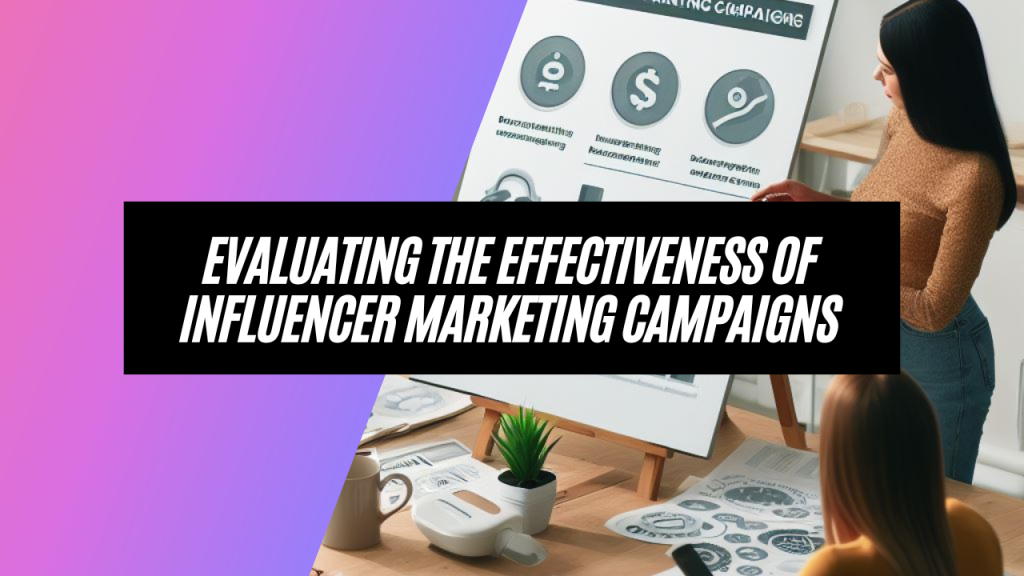Influencer marketing has become a powerful tool for businesses to expand their reach, engage with their target audience, further brand loyalty, and drive conversions. However, how can we ensure that we’re maximizing the return on investment our investment (ROI) in this rapidly evolving landscape? The answer lies in accurately measuring and optimizing the effectiveness of our influencer marketing campaigns.
In this comprehensive guide, we will discuss the frameworks, key metrics, tools, and techniques to help you evaluate and optimize your influencer marketing efforts. From your content strategy and setting SMART campaign goals to leveraging the power of analytics platforms and social media and listening tools, we will provide you with valuable insights to maximize your ROI and achieve your campaign objectives.
Key Takeaways
Establish a framework for evaluating influencer marketing campaigns to measure success and optimize future initiatives.
Select relevant metrics based on campaign goals, target audience, and product purchase life cycle to assess ROI.
Optimize targeting strategies, strengthen relationships with influencers, and test/iterate campaigns for maximum return on investment.
Establishing a Framework for Evaluating Influencer Marketing Campaigns

It’s fundamental to develop a robust framework to accurately measure the success of your influencer marketing campaigns and to guide future initiatives. A well-structured framework enables you to define clear objectives, select relevant metrics, and track your progress, ultimately leading to more effective marketing efforts and higher ROI.
The first step in establishing a strong evaluation framework for your influencer campaigns involves clearly defining your campaign goals and pinpointing the right metrics, that will measure your performance. This will help you stay focused on your objectives and ensure that you are making data-driven decisions to optimize your marketing strategies.
Define Campaign Goals
Establishing clear and quantifiable goals for your influencer marketing campaign enables you to evaluate its effectiveness and make necessary improvements. This is where SMART (Specific, Measurable, Achievable, Relevant, and Time-bound) goals come into play. Applying the SMART criteria to your influencer campaign and goals guarantees that your objectives are both precise and achievable.
For instance, if your primary goal is to increase brand awareness, a suitable SMART goal would be to gain a specific number of new followers on each platform by the end of the campaign. Communicating these expectations to your influencers not only helps them align their content strategies accordingly but also enables you to track their performance and measure the success of your campaign.
Select Relevant Metrics
After clearly defining your campaign goals and target audiences, the next significant step is to choose relevant metrics that will evaluate the success of your influencer marketing. The choice of metrics should be based on your campaign objectives, target audience, and product purchase life cycle.
Metrics such as leads generated, subscriptions, and even sales and revenue generated can be used to assess the success of your campaign. Tracking these metrics not only provides valuable insights into the financial returns from your influencer marketing efforts but also helps you refine your content strategies and targeting to ensure greater resonance and engagement with your audience.
Key Metrics for Evaluating Influencer Marketing ROI

Focusing on key metrics like reach and impressions, engagement, and conversion metrics is crucial to measure the ROI of influencer marketing and track campaign performance of your influencer marketing campaigns. These metrics provide valuable insights into the overall success of your influencer campaign, and help you make informed decisions for future marketing efforts.
Focusing on these key influencer marketing metrics allows you to determine influencer marketing ROI, assess the impact of your influencer campaigns, and use the insights as a foundation for future campaigns, guaranteeing continuous improvement and maximized marketing ROI. By measuring influencer marketing success, you can ensure that your efforts are paying off and make data-driven decisions for your brand.
Reach and Impressions
Reach and impressions are two crucial metrics that measure the extent of influencer content and its potential audience size. Reach represents the number of unique users who have viewed a post or content piece, while impressions calculate the total views of a post or content piece, taking into account multiple views by a single user.
Understanding the difference between reach and impressions is essential for evaluating the potential impact of your influencer marketing campaigns. Tracking these metrics provides insights into:
The extent of your influencer content
Confirming that your marketing efforts are reaching the intended audience
Leading to increased brand awareness and ROI.
Engagement Metrics
Engagement metrics, such as likes, comments, and shares, play a critical role in measuring the level of audience interaction with influencer content. These metrics provide insights into how your target audience is responding to your influencer’s content and whether your campaign is resonating with them.
By monitoring engagement metrics, you can:
Adjust your content and influencer strategies to optimize audience interactions
Increase brand awareness, reach, and conversions
Ultimately contribute to a higher ROI for your influencer marketing efforts.
Conversion Metrics
Conversion metrics are essential in tracking the tangible actions and behaviors influenced by influencer marketing, such as sales, leads, and subscriptions. These metrics help assess the impact of your influencer campaigns on your bottom line and enable you to calculate the return on investment (ROI) of your individual influencers marketing efforts.
Analyzing conversion metrics allows you to:
Assess the effectiveness of your influencer partnerships
Make data-driven decisions about future collaborations
Ensure that your marketing dollars are spent wisely
Ensure that your campaigns continue to yield positive results in terms of conversions and revenue generation.
Analyzing Influencer Performance

Evaluating the performance of your influencers is crucial for maximizing the success of your influencer marketing campaigns. By analyzing factors such as engagement rates, conversion rates, and content quality, you can identify the most effective influencers for your specific campaign, and optimize your marketing efforts accordingly.
This section will delve deeper into the metrics used to track metrics assess influencer performance and provide insights into how you can leverage this information to maximize the ROI of your influencer marketing campaigns.
Influencer Engagement Rates
Influencer engagement rates offer valuable insights into the level of audience interaction with influencer-generated content. Analyzing these rates helps you identify which influencers are resonating with your target audience and adjust your campaign strategies to boost engagement.
High engagement rates indicate that the influencer’s audience is actively engaging with their content, which can lead to increased brand awareness referral traffic, reach, and conversions. Therefore, monitoring and optimizing engagement rates is essential for the efficacy and ROI of your influencer marketing campaigns.
Influencer Conversion Rates

Influencer conversion rates are another critical metric for assessing the performance of your influencers. These rates measure the percentage of people who took a desired action, such as:
making a purchase
signing up for a newsletter
downloading a free resource
registering for an event
After seeing an influencer’s content, it’s not uncommon for people to be influenced by influencer posts the sponsored posts the.
Tracking influencer conversion rates provides insights into the effectiveness of your influencer partnerships and allows you to calculate the return on investment (ROI) of your marketing campaigns. This information can help you make informed decisions when selecting influencers and measuring the success of your campaigns, as well as track influencer marketing performance.
Influencer Content Quality
The quality of the content created by influencers is a key factor in determining the success of your influencer marketing campaigns. High-quality influencers content is characterized by:
Relevance
Authenticity
Creativity
Value
Engagement
Visual appeal
By assessing the content quality of your influencers, you can:
Identify areas for improvement and optimization
Ensure that your campaigns resonate with your target audience
Drive desired actions
Increase brand awareness, reach, and conversions
Ultimately contribute to a higher ROI for your influencer marketing efforts.
Tools and Techniques for Tracking Influencer Marketing ROI

Leveraging a variety of market tools and techniques is crucial to effectively measure and optimize the performance of your influencer marketing campaigns. These include analytics platforms, influencer marketing platforms, and even social media posts and listening tools.
In this section, we will discuss these tools and techniques in detail and provide insights into how they can help you track the ROI of your influencer marketing campaigns and make data-driven decisions to improve your marketing strategies.
Analytics Platforms
Analytics platforms, such as Google Analytics, are invaluable tools for tracking the effectiveness of your influencer campaigns. These platforms allow you to monitor website KPIs such as traffic and conversions, providing insights into the impact of your influencer marketing efforts on your bottom line.
By leveraging analytics platforms, you can track the key performance indicators of your campaigns in real-time, identify areas for improvement, and optimize your marketing strategies to maximize your ROI.
Influencer Marketing Platforms
Influencer marketing platforms, like Klear and Meltwater, offer the following features:
Consolidate analytical data for performance tracking and optimization
Provide extensive influencer databases
Offer charting and visualization of campaign impact
Provide tools to locate, evaluate, and manage campaigns from start to finish
Social media platforms are essential for effective influencer marketing strategies.
By using influencer marketing platforms, you can easily analyze campaign performance, track engagement metrics, and compare the effectiveness of different influencers and content formats, ultimately leading to more data-driven decisions and higher ROI for your marketing efforts.
Social Listening Tools
Social listening tools, such as Brandwatch or Social Mention, monitor user conversations and measure customer sentiment, providing valuable insights into the impact of your influencer marketing campaigns on your target audience. These tools track and analyze online conversations related to your brand or influencer fraud campaign, helping you understand how customers feel about your products and services.
By leveraging social listening tools, you can gain insights into customer preferences, identify trends and sentiment among engaged audience, and optimize your marketing strategies to better resonate with your target audience. This, in turn, can lead to increased brand awareness, reach, and conversions, ultimately contributing to more revenue and a higher ROI for your influencer marketing efforts.
Optimizing Influencer Marketing Campaigns

For maximizing your ROI and achieving your campaign goals, it’s necessary to optimize your influencer marketing campaigns. This involves:
Refining your targeting strategies
Strengthening your relationships with influencers
Testing and iterating your campaigns to find the most effective approach.
In this section, we will discuss the various strategies and tactics you can employ to optimize your influencer marketing campaigns and ensure that you are making the most of your marketing dollars.
Refine Targeting Strategies
It’s important to refine your targeting strategies to ensure that your influencer marketing campaign reaches the intended audience and resonates with their interests, needs, and preferences. By analyzing audience demographics and preferences, you can tailor your campaign strategies to maximize the impact of your influencer partnerships engaged audiences and drive better marketing outcomes.
Leveraging tools like Sprout Social, SEMrush, and Upfluence can help you identify the appropriate influencers, analyze audience demographics, and refine your targeting strategies for your influencer marketing campaigns.
Strengthen Influencer Relationships
Building long-term partnerships with influencers and identifying the most engaging influencers for your campaign are crucial for maximizing the success of your influencer marketing efforts. Some benefits of strong relationships with influencers include:
Heightened sales figures
Greater brand consistency
Improved creative input from influencers
Increased authenticity and trustworthiness.
To cultivate strong relationships with influencers, it is recommended to:
Treat them as collaborators
Reach out in creative ways
Be transparent about expectations
Express gratitude for their efforts and collaboration.
Test and Iterate Campaigns
It’s necessary to test and iterate your influencer marketing campaigns to find the most effective approach and maximize your ROI. By experimenting with different, social media personalities, networks, campaign formats, and influencer types, you can identify the strategies that work best for your brand and target audience.
Implementing A/B testing, providing clear guidelines to influencers, and conducting surveys are some of the methods you can employ to test and iterate your campaigns. By continuously refining your campaign strategies, you can ensure that your marketing efforts build brand awareness are consistently evolving and improving, ultimately leading to higher ROI and increased brand awareness.
Case Studies: Successful Influencer Marketing Campaigns

Investigating case studies of successful influencer marketing campaigns offers valuable insights into the best practices, strategies, and tactics that have delivered impressive results. Some notable influencer marketing campaigns include:
ABSOLUT Planet Earth’s Favorite Vodka Campaign
Uber Eats X Chipotle X Hinge X Rebel Wilson Campaign
Got Milk? Campaign
Fittport #Health And Wellness Campaign
Corona: Choose Glass Campaign
These successful campaigns employed strategies such as identifying influencers in the relevant niche, engaging content, leveraging user-generated content, collaborating with influencers, creating detailed briefs multiple influencers, and developing audience personas to maximize their influencer marketing success, while moving away from traditional advertising.
By learning from these successful campaigns, you can refine your own influencer marketing strategies and achieve better results.
Summary
Influencer marketing has become an essential tool for businesses to reach and keep new customers and engage with their target audience. By measuring the effectiveness of your influencer marketing campaigns and optimizing your strategies, you can maximize your ROI and achieve your marketing goals.
In this guide, we have discussed the frameworks, key metrics, tools, and techniques to help you evaluate and optimize your influencer marketing efforts. By applying these insights to your campaigns, you can ensure that you are making the most of your marketing dollars and driving better results for your brand.
Frequently Asked Questions
How do you evaluate the effectiveness of influencer marketing?
Measuring the effectiveness of influencer marketing involves tracking reach, analyzing audience growth, measuring audience engagement, tracking social leads, using UTM parameters and promo codes to track sales, as well as tracking followers, impressions, campaign/branded hashtags, trackable links, discount promo codes and affiliate links, total engagement, total content, brand awareness, brand mentions, engagement, social media growth, website traffic, sales, downloads of e-products, database growth, and content creation. By closely monitoring these factors, brands can better evaluate the success of their influencer marketing campaigns.
What metrics do you measure in influencer marketing?
When measuring success in influencer marketing, the main metrics to consider are engagement rate, impressions, reach, follower growth, revenue generated website traffic, and conversions.
What is the difference between reach and impressions in influencer marketing?
Reach measures the number of unique users who have seen an influencer’s post, while impressions count the total views of the influencer post regardless of the user.
What tools can be used to track the performance of influencer marketing campaigns?
Tools such as Google Analytics, Klear, Meltwater, Brandwatch, and Social Mention can be used to measure the success of an influencer marketing campaign.
How can I optimize my influencer marketing campaigns for better results?
Optimize your influencer marketing campaigns by refining targeting strategies, strengthening relationships, and testing/iterating for the most effective approach.





